 This article is by Brandy Schaffels of TrueCar.com.
This article is by Brandy Schaffels of TrueCar.com.
Porsche recently gave me the opportunity to attend the Two-Day High-Performance Driving Course at Porsche Sport Driving School. Unlike most other half-day track media experiences, my two days at the Porsche Driving School gave me hours and hours of seat time covering more than 60 high-speed laps around the highly technical 2.38-mile Barber Motorsports Park. PorschePurist is fortunate to visit Barber often, however, if you’re not familiar with it, think steep elevation changes, 16 corners, two blind crests that makes everyone wish they were taller, a corkscrew, and a couple of hairpin turn; it’s like nothing you’ll ever navigate under ordinary conditions.
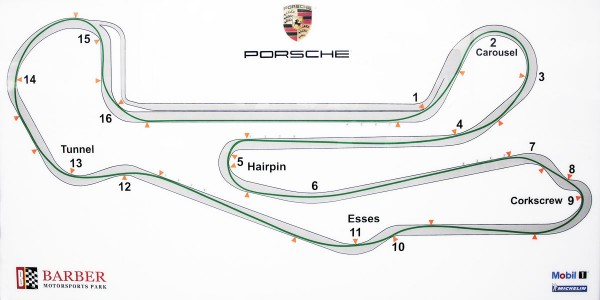
Each day of on track driving is rounded out by additional opportunities including
- The skid pad: here you’ll learn to control your Porsche in the most slippery of conditions.
- The short course: a demonstration of what we learned in the classroom (more on this later) on how braking and weight transfer affect your Porsche’s handling.
- Timed autocross laps: this is an opportunity to compete against the other participants for the fastest and safest laps.
Each of these modules is intended to give drivers valuable information about car control techniques that make sense on the racetrack as well as on regular roads.
As clinical as all this may sound, very little compares to the adrenaline rush that comes from flattening out the gas pedal and hearing the roar of a Porsche’s engine as it accelerates at full power, or the delightful squeal made by the tires when cornering at the edge of their grip.
You Don’t Have to Be a Professional Porsche Driver
When it’s all said and done, you don’t have to be a professional Porsche pilot to use these experiences to improve your everyday driving. While it is possible to hit speeds as high as 100 mph in the straightaways and maneuver through turns as fast as 60 to 70 mph, the true goal is not just to go fast, it’s to learn how to do so safely and smoothly, while becoming more aware of your surroundings and understanding what your Porsche is capable of handling. Safety is always the highest priority. In fact, more than 12,000 students have participated at the Porsche Sport Driving School over the last 12 years, all of them leaving the course feeling much more capable and confident in everyday situations.
What Porsches Did We Drive?
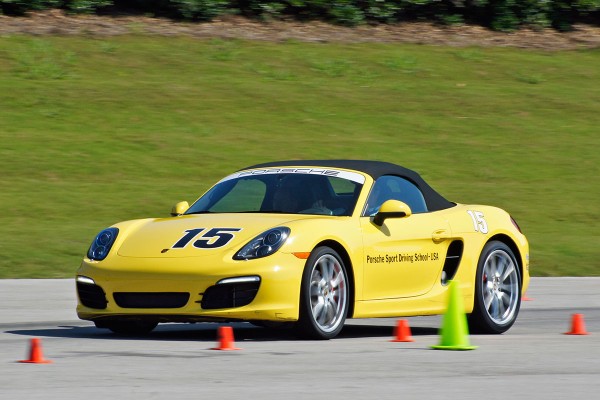
Right now, Porsche Sport Driving School participants are among the first consumers in the United States to drive the brand-new 2013 Porsche Boxster S on the track or autocross course (at the time of our class, the new Boxster wasn’t even on sale yet in the United States). We’ve reviewed the new 2013 Boxster here on PorschePurist before so we won’t go into too much additional detail. Let’s just say the new Porsche Boxster is pretty close to perfect and one of many great training tools in the Porsche Sports Driving School garage.
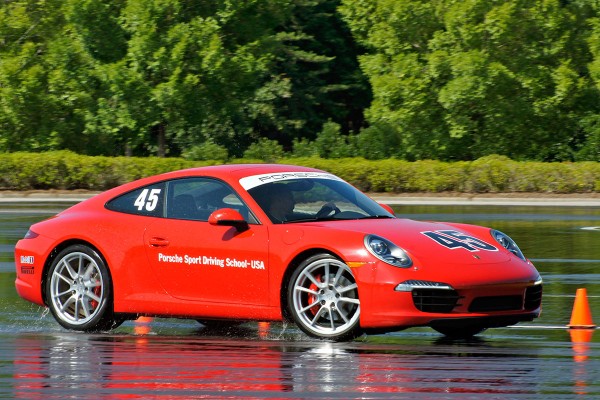
We also drove the new Porsche Carrera S on the track and on the skid pad, the Cayman S in braking and handling exercises, and had seat time in the Cayenne S on the off-road course. Participants can drive these vehicles with traditional manual transmissions if they prefer shifting with a clutch, or with the high-tech Porsche Doppelkupplung (PDK) dual-clutch automatic manual transmission with steering-wheel paddle shifters.
Day One at The Porsche Sport Driving School
We gather for a continental breakfast at the track while participants share their prior track/driving experience as well as what they hope to learn over the next couple days. Attendees range from those with club racing backgrounds to one gentleman with zero racing experience but is here because he (as he put it), “recently bought his first Porsche, and his wife wanted to be sure he knew how to drive it safely.” Surprisingly, only a few attendees actually already own Porsche vehicles — the rest of us are just high-performance driving wannabees, looking for a chance to drive hard and fast under safe, controlled conditions. (That would be me.)

After a brief classroom lesson discussing how tire grip is affected by the weight transfer caused by acceleration and braking, and an overview of the track, we are divided into small groups and sent to participate in one of four performance modules:
1. autocross
2. performance driving and braking techniques
3. wet skid pad handling
4. full-speed on-track hot laps
Part of this first day is as much about becoming familiar with the cars, the track, and the driving, as it is about getting to know your teammates. Exercises are taught in a fun way to help bring strangers with a variety of driving backgrounds together so that participants bond into friendly and supportive groups. We will all rotate through these modules during our time here to gain familiarity with each aspect of the training, building to faster lap-times, as our skills are refined.
The Instruction
In-class and on-track courses are taught by actual race drivers, who provide helpful guidance mixed with delightful humor to keep the instruction informative and entertaining. Most of you are familiar with Chief driving instructor Hurley Haywood (and his impressive racing credentials including five wins at the 24 Hours of Daytona, three at the 24 Hours of Le Mans, and two at the 12 Hours of Sebring). But it’s not just Hurley with the impressive resume. All the instructors at the Porsche Sports Driving School come with amazing racing pedigrees. Of the many instructors I interact with over my two-day course, I find all of them to be helpful and patient, but most of all, fun and engaging. They know their stuff, and they teach it in a way that makes it easy for us to learn from them.
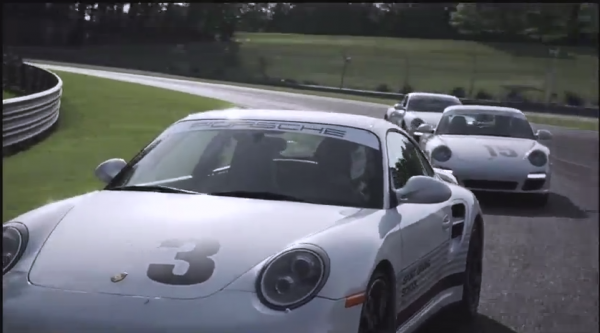
Our first few laps around the track are taken not in a Porsche but in a van full of students, while the driver explains the turns, identifies the braking points, and demonstrates the proper line to take from turn to turn. After that introduction to the track, each student drives alone in a follow the leader format that gives every participant a chance to follow directly behind the instructor. Speeds gradually increase as students become more comfortable with the driving line.
I confess: I was anxious when I climbed behind the wheel of the Porsche Carrera S for my first laps alone. “What if I miss a turn? What if I spin out or drive off the track? What if I look like an idiot? What if I HIT somebody?” Yes, I worried about every possible negative outcome.
None of that happened.
If you can’t see the video above (or a couple of paragraphs below) simply click here to view directly on FlatSixes.com.
In fact, after my first day of racing, I ‘m frustrated because I don’t feel that I’m going as fast as I want to go (and I don’t like being the slowest driver in the pack).
Day Two at The Porsche Sport Driving School
When I hit the track on the second day, instructor Richard Hull takes a ride in my passenger seat where he helps identify what I’m doing wrong: He tells me I need to “accelerate longer, don’t lift in anticipation of braking, then brake harder.” It is an “aha” moment that completely changes my driving technique (and improves my entire experience), because it is so different from what we’re taught when we’re trying to earn our driver’s licenses. Nobody ever told me to accelerate longer and brake harder. Until now!
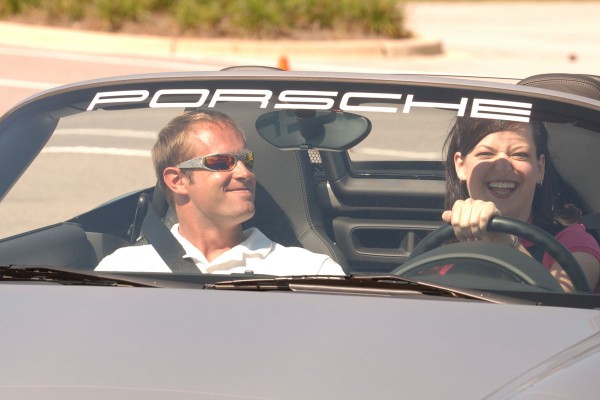
The next-best piece of coaching comes from the instructor who tells us, “Use your personal guidelines — like your heart rate — to know when you’ve hit your limit.” After my driving technique revelation, I feel extremely confident. But I also know I have to listen to my heart rate so I won’t accelerate so much longer that I get into trouble by braking too late into the turns. (Nobody wants to be that person who takes a car off the track. Forget concerns about safety; it’s just plain embarrassing.)
So What Did I Take Away From the School?
Well, aside from a flash drive documenting my last laps of the event and a burning desire to go back to attend the next level, I learn that becoming a better driver does not necessarily mean being a faster driver. I may not be amongst the fastest drivers on the track, but my lines through the turns are great, and I’ve made a significant improvement over my skills from the previous day.
As much as I enjoyed the opportunity to drive fast on the track (which was my original reason for wanting to attend), I also learned how to drive a Porsche (or any car for that matter) better in a variety of different road conditions (such as how to stay in control on slippery roads, or when avoiding obstacles in the road), and how to better utilize the handling and performance of the car I was driving (have you ever felt your own Porsche’s ABS or stability control functions when they kick in?). These are lessons much better learned under safe, controlled circumstances.
Ultimately, attending the school has made me a safer, more confident driver… and that’s what really matters, isn’t it?
Five Things I Learned
1) You go where you look. If you’re driving faster, look farther ahead.
2) Driving better doesn’t mean driving faster, nor does driving faster mean you’re a better driver.
3) Trust your instincts. If conditions make you nervous, slow down.
4) Don’t overreact. Sometimes only a small response is all that’s needed.
5) Don’t crash faster. If it’s an emergency and you need to brake, brake hard with both feet.
Interested in Attending?
Find out more about attending the Porsche Sport Driving School by visiting their website at PorscheDriving.com. Classes are ongoing and include one-day Precision courses ($1,800), two-day High-Performance courses ($3,200), and three-day Master’s courses ($5,700). I attended the two-day course and was one of two women along with about 30 men; when I asked the other woman how she felt about participating alongside all the guys, she said she didn’t notice them. And honestly, I felt they were all quite courteous and supportive of my presence as well.
For women who might prefer to be in a class without men, Porsche also offers a “Women’s Only” course designed exclusively for women drivers. What’s different about the “Women’s Only” course? Very little! Bathroom breaks are a little longer, but the instruction is the same: only the attendees are different. According to one instructor, “Women participants are more open-minded and more receptive to instruction.” Prodded further, he explained, “Women are better students. They ask more questions and respond to correction without interference from their egos.” (Amen, brother.) Another instructor told me the women’s groups tend to be more supportive of each other, encouraging and cheering their teammates much more enthusiastically than the men’s groups, who tend to be more competitive. The next one is September 5-6, 2012, so if this sounds interesting, make your reservations right away!
About the author: Brandy is an automotive journalist with more than 25 years in the industry. Previously an editor at MotorTrend.com and AskPatty.com, Brandy is now the Senior Editor for TrueCar.com.
[Photos: via Porsche and post author]
Other Porsche Blog Posts You Will Be Interested In
Come With Us as we Visit Barber Motorsport Park to get Behind the Scenes of a Porsche Video Shoot
Michelin Tire School. What Is It and Why Did We Go?
Porsche 911 GT3 Cup Two-Seater Introduced to Porsche Sports Driving School
Porsche Motorsports Terminology: Part 1